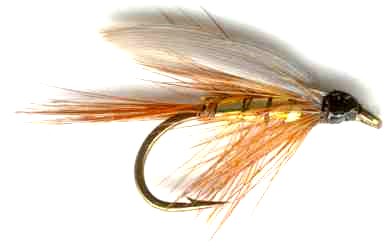Wickham's Fancy Caddis (Sedge) Wet Fly
The Wickham's Fancy Caddis has a metallic gold palmered body to help attract the attention of passing predatory Trout. The sun light in the water reflects off the gold colored material and catches the eye of the fish hopefully increasing the amount of strikes.

CADDIS WET FLY PATTERNS. Hook size 10 12 14 - $US each
There are two claimants to being the designer of this general caddis attractor pattern. Dr T.C. Wickham, instructed Winchester fly-tyer Jack Hammond to make him some copies of a fly called the Cockerton that he used to use in his younger days. When they were finished they did not quite match the old pattern. There was a lot more gold on the body and less hair. The Doctor took them fishing just the same on his next river trip on the river Test in Hampshire, Southern England. The fly turned out to be a killer. At the same time another Winchester Fly-Tyer, George Correll stated that he had made the same pattern for a Captain John Wickham in 1884. Before the development of nymph fishing in the twentieth century the Victorians used this wet fly to imitate caddis pupae.

The common or slang term ‘sedge’ originates from the fact that adult Caddis flies can often be found clinging to sedge grass near the waters. Sedge/Caddis flies have four wings. The forward pair are normally a little longer than those at the rear. At rest their wings lie close along the body in an inverted V shape. Caddis flies do not have tails but many have long antenna. The Latin name for this group of flies is ‘Trichoptera’ (Greek for 'hairwing'). They pass through four stages in their development; egg, larva, pupa and adult. The eggs are laid by the adult female in large jelly mass, which often floats on the water surface and drift until they stick to some river side vegetation. Some species lay their eggs directly on vegetation.
CUSTOMER'S COMMENT
When fishing the Derwent reservoir from the bank or whilst wading, I usually rely on two flies rather than a river team of three. I space them at least three feet apart on a twelve foot leader. On the Derwent you will be throwing your flies across a stiff breeze with perhaps a steep bank behind, which is covered in tall tufts of grass. I find it makes sense to use a tapered leader which you can make with equal lengths of nylon with a differential of 2lb braking strain between them. I work down to a point breaking strain of 4 or 5lb. I like to have the dropper standing proud of the main leader to reduce tangles. My preferred point fly is a Wickhams Fancy Wet especially on sunny days. The tinsel body reflects and available light and seems to attract the trout. I will tie on a
silver Invicta on the dropper. I return to Derwent again and again as the beautiful scenery becomes more important to me as I get older. I like to fish in attractive surroundings and appreciate what nature has to offer. The water is stocked with rainbow, blue trout and the odd prize tiger trout. There are some good brown trout as well. - James Elgar


Fly Fishing books

